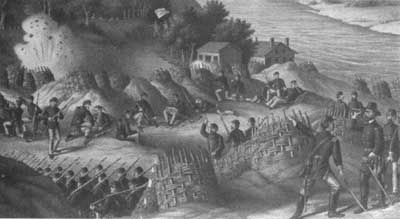 | ||
 | ||
 | ||
 | ||
 | ||
 | ||
 | ||
 | ||
 | ||
 | ||
 | ||
 | ||
 | ||
 | ||
 | ||
 | ||
 |
 |
 |
Vicksburg National Military Park Tour Roads
Vicksburg, Mississippi
VICKSBURG: A CITY UNDER SIEGE
Situated on the bank of the Mississippi River, Vicksburg was a prime location for controlling the movement of troops and supplies during the Civil War. Thus, this vital city was considered the key to victory.
After several failed attempts to control Vicksburg in 1862-1863, Maj. Gen. Ulysses S. Grant took a daring course of action that ultimately resulted in victory. Crossing the Mississippi River below the city, Union troops pushed deep into Mississippi, defeated Confederate forces in five battles, and drove the Rebels back into the Vicksburg defenses.
Grant then ordered two ill-prepared assaults on Vicksburg. The topography of the land worked in favor of Confederate troops, who held the high ground and had fortified their city. Forced to devise a new strategy, Grant ordered his army to begin siege operations. Vicksburg was pummeled by cannon fire, while Federal troops inched their way towards enemy earthworks though zig-zagging trenches. Cut off from supply lines for over six weeks, Lt. Gen. John C. Pemberton was no longer threatened by enemy fire, but faced the greater danger of losing his soldiers to starvation and desertion. After 47 days under siege, Vicksburg was finally forced to surrender on 4 July 1863.

Kurz and Allison print of the Siege of Vicksburg ca. 1870s. (Library of Congress) |
ESTABLISHMENT OF A MILITARY PARK
The South was left devastated by the Civil War and Vicksburg was no exception. Financial difficulties resulting from the expense of rebuilding homes and businesses exacerbated the bitterness and hostility Southerners felt over their defeat. For these reasons, the battleground at Vicksburg remained largely under private ownership, unpreserved and unprotected for over three decades.
On 18 September 1889, when veterans of the 24th Iowa Infantry gathered on the Vicksburg battlefield for a reunion, they were shocked to discover that the ground they considered sacred had been all but forgotten, as the South struggled to recover from the devastation caused by the war. The only marker to speak of was an inscribed cannon commemorating the site of the surrender interview between Gen. Ulysses S. Grant and Gen. John C. Pemberton.
In October 1895 these veterans began a movement to establish a national park at Vicksburg. In cooperation with veterans' groups like the Blue and Gray Association John F. Merry, a veteran of the 21st ??? Iowa Infantry, organized the Vicksburg National Military Park Association (VNMPA). Officially incorporated on 22 November 1895, the VNMPA immediately began lobbying Congress to appropriate funds for the preservation of the Vicksburg battlefield and its establishment as a national military park.
The Vicksburg park bill, proposing expenditures of $50,000 for land acquisitions and $25,000 for grounds improvements and restorations, was first introduced in 1896, by Representative Thomas B. Catchings of Vicksburg. Action on the bill was slow, requiring a reintroduction in the next congressional session. War with Spain in February 1898 further stalled action on the park bill. It was another year before the bill passed the House of Representatives and the Senate to be signed by President McKinley on 21 February 1899.
| Introduction | Acadia | Blue Ridge Parkway | Colonial Parkway | Generals Highway | George Washington Memorial Parkway | Great Smoky Mountains | Mount Rainier | Rock Creek and Potomac Parkway | Shenandoah's Skyline Drive | Southwest Circle Tour | Vicksburg | Yellowstone | Yosemite | Discover History |
